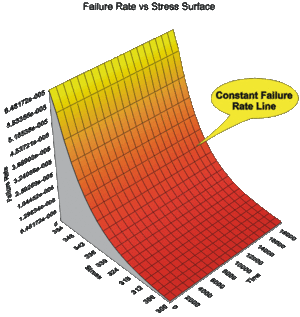ALTA ALTA Standard Folio Data IPL-Exponential: Difference between revisions
Jump to navigation
Jump to search
No edit summary |
No edit summary |
||
| Line 10: | Line 10: | ||
|- | |- | ||
| align="center" valign="middle" | | | align="center" valign="middle" | | ||
==IPL-Exponential== | |||
<br> | |||
| | The IPL-exponential model can be derived by setting <math>m=L(V)</math> in Eqn. (inverse), yielding the following IPL-exponential <math>pdf</math> : | ||
<br> | |||
::<math>f(t,V)=K{{V}^{n}}{{e}^{-K{{V}^{n}}t}}</math> | |||
<br> | |||
Note that this is a 2-parameter model. The failure rate (the parameter of the exponential distribution) of the model is simply <math>\lambda =K{{V}^{n}},</math> and is only a function of stress. | |||
<br> | |||
[[Image:ALTA8.4.gif|thumb|center|300px|IPL-exponential failure rate function at different stress levels.]] | |||
|- | |- | ||
| align="center" valign="middle" | [http://reliawiki.com/index.php/Template:Ipl_exponential#IPL-Exponential Get More Details...] | | align="center" valign="middle" | [http://reliawiki.com/index.php/Template:Ipl_exponential#IPL-Exponential Get More Details...] | ||
Revision as of 00:03, 14 January 2012
|
Reliability Web Notes |
|---|
| Standard Folio Data IPL-Exponential |
| ALTA |
IPL-Exponential
|
| Get More Details... |
| [Link2 See Examples...] |
